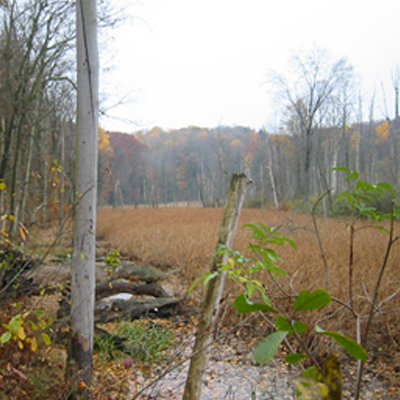
Autumn Wetlands
It’s fall and wetlands have transformed in response to the reduced hours of sunlight and lower temperatures that come with the changing season. Wetland vegetation communities are no longer photosynthesizing and the individual plants have either died or gone into their winter period of dormancy. Marsh vegetation has become yellow and wilting, swamp forest tree leaves are turning brilliant colors and dropping from their branches, and vernal pools no longer have standing water. Their substrates are becoming covered with a new layer of vividly marked fallen leaves overlaying the existing weathered dull brown, gray and black leaves of previous years. With the die off of fen vegetation it is easy to see the marl deposits and cold clear water flowing in rivulets as there is no standing vegetation to interfere with the view. The change in air temperatures provides a heavy mist abethe warmer water of the bogs in the mornings, and the smell of decaying vegetation is intense.
Yes, the wetlands look, feel and smell different this time of year as there are large scale changes occurring in their biological, physical and chemical components. However, the wetlands are not fully asleep; they are still providing an array of valuable ecosystem services. Flood control, sediment and nutrient retention and export, and water purification processes are still being performed at high levels by these seemingly sleeping systems. Wetlands continue to handle storm water from fall and winter rains and snowfalls, transform pollutants in their water columns and settle out newly deposited sediments protecting downstream aquatic resources. Even the biodiversity abilities of wetlands are not truly on vacation this time of year.
For some species, their life cycle is fully dependent on the conditions in wetlands during the fall and winter. Marbled Salamanders breed and lay their eggs in wetlands in the late summer and early fall. Eggs hatch in the late fall or winter and larvae are present, eating invertebrates and growing in the wetland waters, often under substantial sheets of ice. Neotropical migrants and waterfowl rely on the refuges provided by wetlands distributed throughout the landscape for rest, cover, and food sources as they make their way along flyways in their seasonal movements to warmer climates. At the same time, their presence in the wetlands provides recreational opportunities for birdwatchers and hunters alike.
The value of wetlands is most readily apparent in the spring and summer when their biological communities and corresponding ecosystem services are at the height of their glory. However, while altered in their appearance and functions, wetlands continue to provide important benefits to humans and their watersheds throughout the year.
